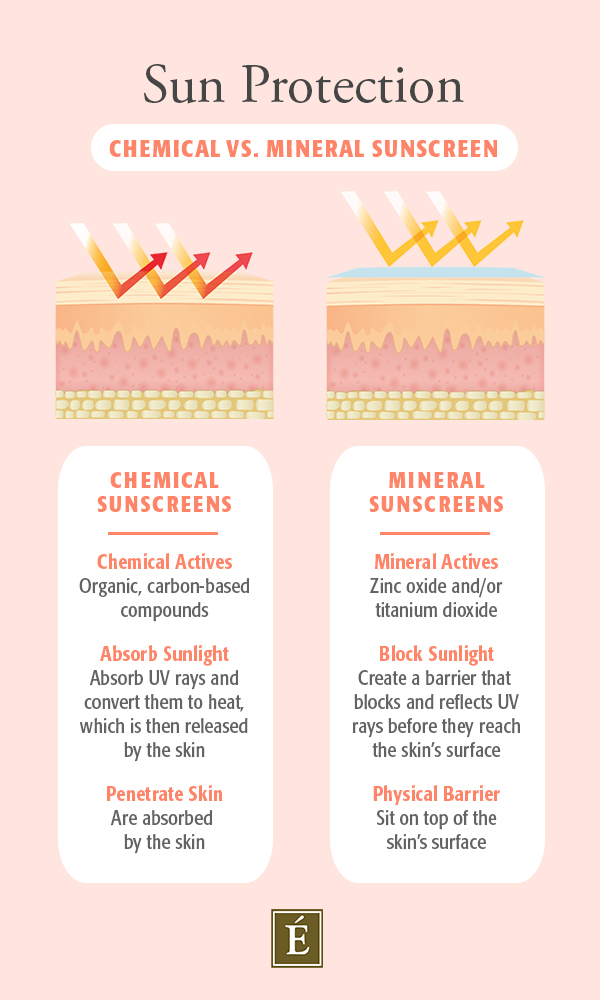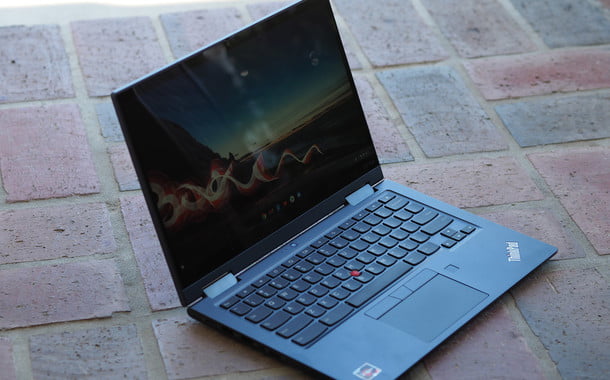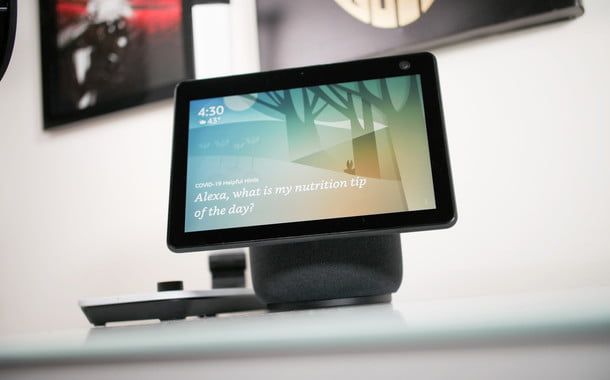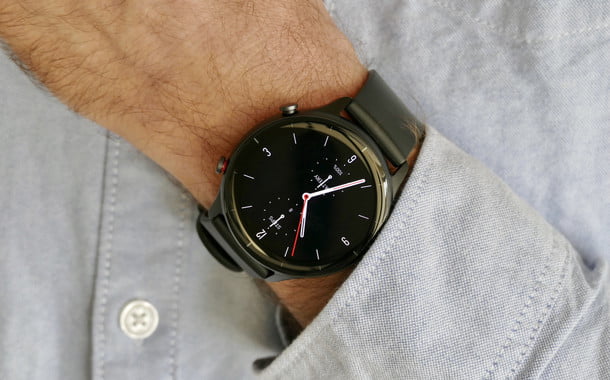Chemical Vs. Mineral Sunscreen: What’s The Difference?
You need daily sun protection to keep your skin healthy and looking youthful. But what type of sun protection should you choose? Sun protection generally falls into one of two categories: chemical and mineral (physical). While both provide sun protection, chemical sunscreens and mineral sunscreens differ in their active ingredients, as well as the way they protect against UV radiation. Read on to learn the difference and discover the benefits of a mineral sunscreen.
Chemical Vs. Mineral Sunscreen
Sunscreens are important to protect the skin from the dangers of sun exposure, including sunburn. Sun damage and melanoma. It is also beneficial to minimize the aging effects of UV rays such as fine lines and wrinkles, rough skin, and hyperpigmentation.
Chemical sunscreens are often referred to as "absorbers". Its active ingredients are organic compounds (based on carbon) that absorb UV rays. Through a chemical reaction, these chemical compounds convert UV rays into heat and transfer this heat to the skin.
Mineral sunscreens, on the other hand, are "reflectors". Their active ingredients include zinc oxide and titanium dioxide, which act as physical blockers. These minerals form a protective barrier on the skin and reflect harmful UV rays before they come into contact with the skin's surface.

What is zinc oxide?
Mineral sunscreens typically use zinc oxide as a physical sunscreen for UV rays. Yes, the same zinc that your parents put on your nose and cheeks in the 80s. Zinc oxide has come a long way since then and is now found in Lightweight, layerable formulas that offer the same sun protection but have a natural-looking finish. Here's a look at the many benefits of zinc oxide for the skin.
Zinc oxide keeps the skin cool
Unlike chemical sunscreens, which trap UV rays and convert them into heat, zinc oxide keeps the skin cool and lets it breathe. It reflects the heat and energy of the sun's UV rays away from the skin, thus maintaining the skin temperature. For this reason, mineral sunscreen is particularly beneficial in minimizing the skin Inflammation and redness associated with acne, rosacea, and skin sensitivity.
Zinc oxide provides physical sun protection
While zinc itself occurs naturally, zinc oxide is actually created by combining the mineral zinc with oxygen molecules. When these two elements are evaporated and condensed, they form a fine powder that sits on the skin and provides a protective barrier against UVA and UVB rays. In addition to being a physical blocker, zinc oxide acts as a mirror to reflect UV rays before they can penetrate the skin's surface.

Supports collagen production
UV radiation is the number one cause of premature aging. Sun damage exposes the skin to harmful free radicals that break down and destroy collagen, a protein important in keeping the skin firm, plump, and elastic. Zinc serves as Co-factor in collagen synthesis by activating protein collagenase. This protein triggers collagen production to build and repair connective tissues like your skin.
Helps in treating acne
Zinc oxide is also beneficial in treating acne-prone skin tones. Studies show that zinc is effective at reducing skin levels Inflammation, inhibits the growth of acne-causing bacteria and regulates the activity of the sebum glands. It also has astringent properties that narrow pores and minimize their appearance.
Mineral sun protection benefits
If you're new to the superpowers of zinc oxide, there are a few more reasons to add a mineral sunscreen to your daily skin care regimen.
Reef friendly
Mineral sunscreens are more environmentally friendly – zinc oxide and titanium dioxide protect the sensitive coral reefs on our planet. They are a preferred choice for beach vacationers and destination travelers visiting seaside resorts.
Suitable for all skin types
Mineral sunscreens are hypoallergenic and non-comedogenic. With their anti-inflammatory properties, they are gentle enough for the most sensitive skin types. And they're free of pore-clogging silicone, making them a better option for those who are prone to failure.
Broadband UV protection
Mineral sunscreens reflect both UVB and UVA rays from the surface of the skin. Cause UVB rays Sunburn and uncomfortable symptoms such as redness, dryness and itching. UVA rays, which penetrate deeper into the skin, are responsible for premature aging and play a key role in the development of melanoma.
Which purely mineral sun protection suits you?
Protecting your skin from sun damage is one of the most effective ways to slow down the visible signs of aging and keep your skin looking and feeling healthy. Now that you know the benefits of using mineral sunscreens, you can have ours All SPF mineral moisturizers.
Our range of four unique, daily mineral moisturizers with sun protection factor have been specially developed for the face and neck. Each formula is silicone-free and full of active ingredients to achieve targeted skin benefits and prevent sunburn.
Red Currant Protection Moisturizer SPF 40
This matting The daily moisturizer contains a Youth Shield Antioxidant Complex and SPF 40 mineral protection. This SPF moisturizer provides sun protection and helps with the appearance of wrinkles. Red currant is a source of vitamin C, an antioxidant with added bioflavonoids that improves the appearance of fine lines.
Tropical Vanilla Day Cream SPF 40
Sometimes scents can take us to a dream destination, and that Tropical Vanilla Day Cream SPF 40 does just that with its fresh, tropical scent. This purely mineral sunscreen contains vanilla, shea butter and SPF 40, all mineral sunscreens to revitalize the skin and prevent sunburn. Shea butter is a moisturizing ingredient that is high in triglycerides and fatty acids. This makes the cream an effective emollient for skin that needs more moisture.
Lilikoi Daily Defense Moisturizing Cream SPF 40
This all-in-one lightweight every day The moisturizer is made from Cocoa Seed Extract, Satsuma Mandarin Peel, and SPF 40, all of which protect minerals to improve the appearance of skin exposed to blue light stress and pollution. If you've been exposed to blue light in front of electronic devices all day, this moisturizer is for you. Cocoa seed extract is included in this formulation, a blend of cocoa peptides, saccharides and polyphenols to improve the appearance of skin exposed to blue light stress.
Bright Skin Moisturizer SPF 40
This lightening daily moisturizer contains a Natural hydroquinone alternative and SPF 40 all mineral protection. This SPF formula targets the appearance of dark spots and prevents sunburn. The natural hydroquinone alternative will help fade the appearance of dark spots and create a smooth, even complexion.
Learn more about our mineral SPF moisturizers and how to use them in this video:
(embed) https://www.youtube.com/watch?v=HkVMaiUeToY (/ embed)
In addition to our SPF moisturizers, we recommend our Lilikoi Mineral Defense Sport Sunscreen SPF 30 for protection from head to toe. This easy-to-use sports formula for the face and body is non-greasy and water-resistant for up to 40 minutes.
Do you add mineral or chemical sunscreens to your skin care regimen? Let us know in the comments below and join the conversation on social media. Experience our mineral SPF moisturizers and Lilikoi Mineral Defense Sport Sunscreen SPF 30 at an Eminence Organics Spa partner near you.
Product selection

Lilikoi Daily Defense Moisturizing Cream SPF 40
VIEW PRODUCT
Red Currant Protection Moisturizer SPF 40
VIEW PRODUCT
This post was originally published in April 2019 and has been updated for accuracy and completeness. .
































